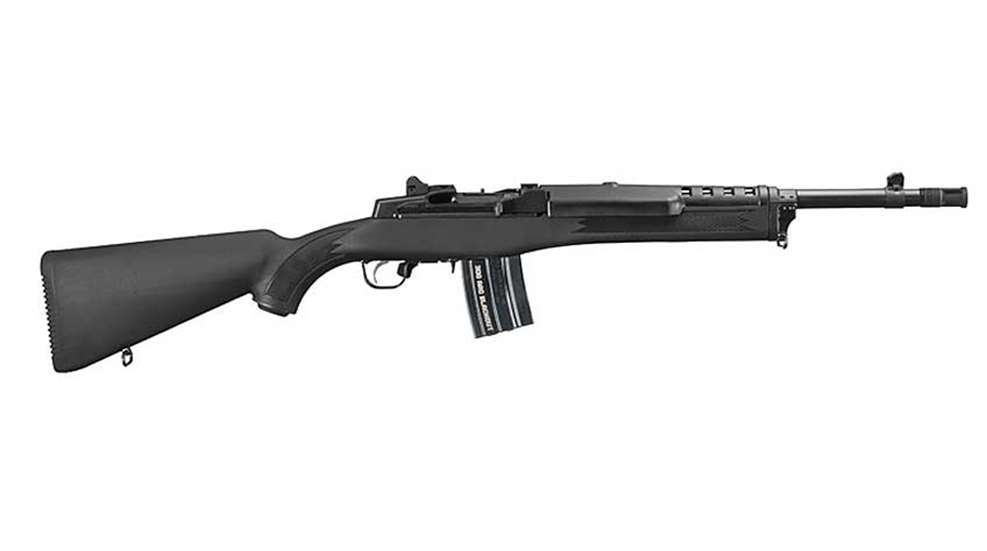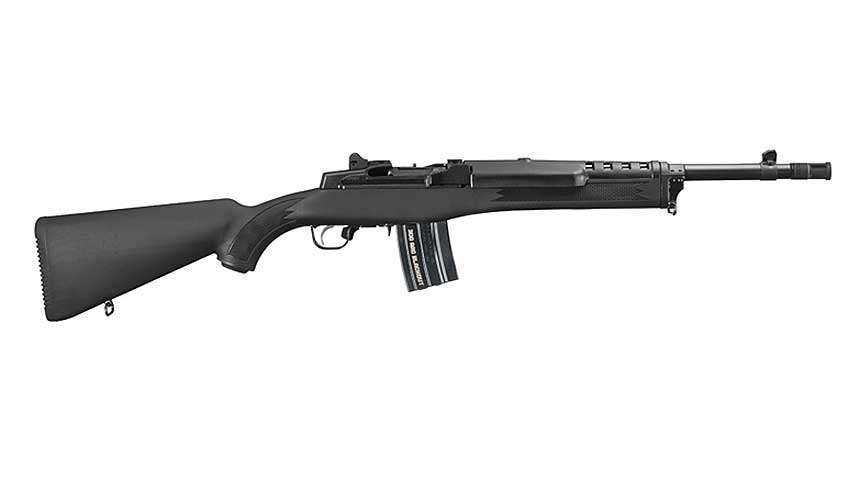
I started by looking into AR-15 and AK-style rifles. Due to the Clinton-era Federal Assault Weapons Ban (enacted about five years prior) and concerns about the Y2K bug bringing civilization to a grinding halt, these two platforms were hard to find. Those rifles and pre-ban magazines that were available had price tags that were out of sight.
My associates at the sporting goods store where I was working suggested I take a look at the Mini-14 Ranch Rifle. Even though it shot the same 5.56 NATO/.223 Rem. cartridges as the AR and would accept 20- and 30-round magazines, it wasn't one of the guns restricted under the 1994 ban. It didn’t have a telescoping stock, pistol grip or an oh-so frightening flash suppressor. Instead, it shipped with an unadorned muzzle, a five-round magazine, and an innocuous wooden stock. The Mini-14 might not have been the most accurate rifle in the world, but it was rugged, reliable and available.

I was able to find a lightly used stainless steel Mini-14 for what was, at the time, a very fair price. A little more digging around turned up a handful of factory 20-round magazines that were being sold at close to their original retail price. Not only did it reliably digest all of the various types of ammunition it was fed, it was fun to shoot.
The years passed, the ban came to an end, and somewhere along the way that stainless Mini-14 was traded away for something else. It’s one of those choices that I still regret. When I learned that Ruger had a newer model chambered in .300 AAC Blackout, it seemed like the perfect time to revisit the rifle.
Originally launched in 1974, the Mini-14 was designed by L. James Sullivan and William B. Ruger. The inspiration for this carbine was none other than the venerable M14 combat rifle. Using this tested design as a guide, they scaled down the dimensions to suit the 5.56 cartridge while incorporating their own innovations and cost-reducing changes.

The result of their labors was a popular semi-auto rifle that employs a proprietary fixed piston and self-cleaning moving cylinder gas system to cycle a modified Garand-type rotating bolt. This action is not only reliable, it's easy to field strip and clean without the need for tools to do so. Eventually the rifle was chambered in more calibers, including the 7.62×39mm (Mini Thirty), 6.8 SPC, and the .300 AAC Blackout. In addition to the Ranch Rifle, customers can now purchase specialized Tactical models.
The Mini-14 Tactical reviewed here (Model 5864) features a heat-treated blued steel receiver. Steel is used to form the rest of the key components, including the bolt, bolt handle, trigger, trigger guard, sight system and barrel. The 16.1" hammer forged barrel has a straight, non-tapered profile of 0.75" with a threaded removable flash suppressor.
The rifle's iron sights consist of an adjustable ghost ring aperture rear sight with a protective winged housing and a protected post sight in the front. This version of the gun allows optics to be mounted to the receiver in two ways. Use the milled-in Ruger integral scope mount, or attach a 4.25" long Picatinny compatible rail using three screws for which the receiver has already been drilled and tapped. Ruger ships this Mini-14 with a pair of 1" blued steel scope rings for the integral mounts and includes the rail with mounting hardware.

The fixed black polymer stock on this model takes its cues from the wood stock of the Ranch Rifle. Diamond pattern checkering is molded into the sides of the grip and fore-end. A smooth black polymer hand guard with a metallic heat shield protects the shooter's hands from the hot barrel. The shoulder stock provides a 13" length of pull (LOP) and is capped off with a grooved soft rubber recoil pad. Shoulder sling loops are mounted to the gas block and under the shoulder stock.
The Garand-style bolt handle is found on the right side of the receiver. A small spring-loaded pin mounted on the top left side of the receiver can be depressed to lock the bolt open when the bolt is pulled all the way to the rear. The bolt assembly on this particular factory-fresh gun felt a little rough at the start, but it cycled reliably and smoothed out as the testing progressed.
The steel bow trigger is housed in a stamped sheet steel trigger guard. This trigger had just a bit of takeup, breaking at 5 lbs. 10 ozs. of trigger pull with no over-travel after the break. The rifle's blade-shaped safety lever is mounted in front of the trigger guard. Pulling it back towards the recoil pad using the trigger finger blocks the trigger from cycling. Pressing it forward to release the safety produces a clearly audible click.
The two steel 20-round magazines provided with this rifle stamped "300 AAC Blackout" on the right side in white lettering are mechanically identical to the .223 models. The magazines rock and lock into place much like those of an AK-47. The release lever is located behind the magazine well where it is pressed forward to release the magazines. The bolt does hold open when the last round in the magazine is fired. The rifle passed the bench checks with flying colors, so it was time to take it to the range.

With the growing popularity of the 300 AAC Blackout (also known as the 7.62×35mm or 300 BLK), which uses a .223 Rem. case necked up to accept 0.308-cal. bullets, it only makes sense that Ruger would chamber this rifle to fire it. The Mini-14 Tactical handled nicely during off-hand shooting. The polymer sporting stock was light weight and comfortable to hold. The felt recoil was perfectly manageable with the rubber recoil pad providing positive traction at the shoulder. Like other aperture systems, the iron sights provided quick target acquisition for reliable combat accuracy.
To check bullet velocity, the rifle was strapped into a rifle rest and fitted with a MagnetoSpeed V3 Ballistic Chronograph. Instead of placing a set of IR sensors out in front of the rifle 10 to 15 feet (where it can get shot or rained on), the MagnetoSpeed uses a bayonet shaped sensor that straps directly to the barrel of the rifle.
Firing 10 shots per load over the MagnetoSpeed, Gorilla Ammunition 125-gr. Sierra Matchking open tip rounds averaged 2195-fps. Remington Premier 125-gr. Accutip bullets flew at 2211-fps. Both loads ran without a hitch. But the rifle did not function reliably with the sub-sonic loads I had on hand. Rounds like the Remington Express Rifle 220-gr. sub sonic open-tip match round, traveling at an average of 1002-fps, would stove pipe on just about every shot. Is the problem somewhere in the rifle or the ammunition? I don't have enough information to make a determination just yet. This was another good reminder as to why ammunition testing is so important when breaking in a new rifle.
For formal bench-rested accuracy tests firing five-shot groups at 100 yards, I stuck to the two loads that were cycling properly. Using an Alpen Optics Kodiak 3-9x40 wide angle scope attached with the provided 1” rings, the Gorilla 124-gr. Sierra load produced a best single group of 1.47" with an average of 1.71". The Remington Premier 125-gr. Accutip's best group was 1.57" with an average of 1.87".

Spending time with the Ruger Mini-14 Tactical rifle chambered in 300 AAC Blackout was a great reminder that in a semi-auto carbine market currently driven by AR and AK platforms, there is a third option. Although past models had a reputation for so-so accuracy, this rifle shows a marked improvement. The Mini-14 offers reliability in a configuration that is easy to operate and maintain.
Ruger Mini-14 Tactical 300 BLK Specifications
Manufacturer: Sturm, Ruger & Co.
Model: Tactical Mini-14 (5864)
Action: Fixed Gas Piston Semi-Auto
Caliber: .300 AAC Blackout
Finish: Blued Alloy Steel
Stock: Fixed Black Synthetic Front
Sight: Fixed Blade Rear
Sight: Adjustable Aperture
Scope Mount 1: Integral Ruger Scope Base (Rings Included)
Scope Mount 2: Picatinny Rail (Rail Included)
Muzzle: Removable Flash Hider
Barrel Length: 16.1"
Overall Length: 36.25"
Length of Pull: 13"
Weight: 6.75 lbs.
Capacity: 20-Round Removable Box Magazines
Twist: 1:7" RH Rifle Grooves:
Six Accessories: 2 Magazines, 2 Scope Rings, 1 Picatinny Rail, Owner's Manual, Lock
MSRP: $1089






































